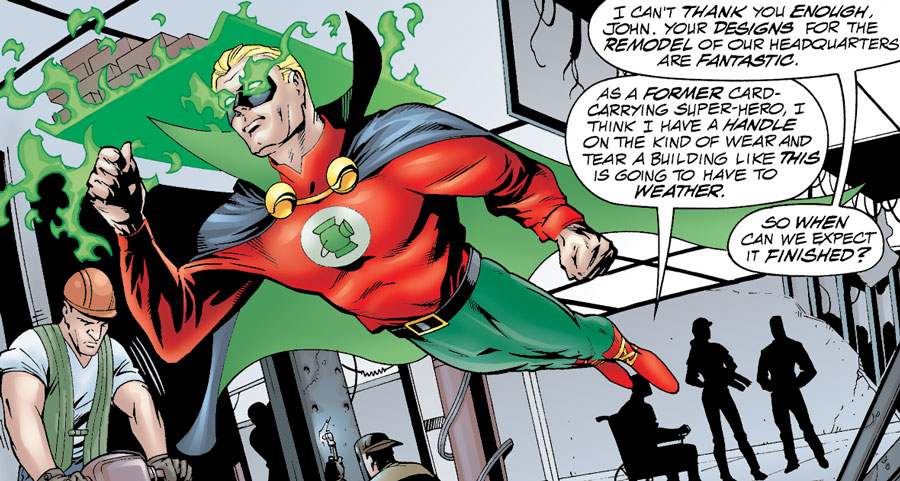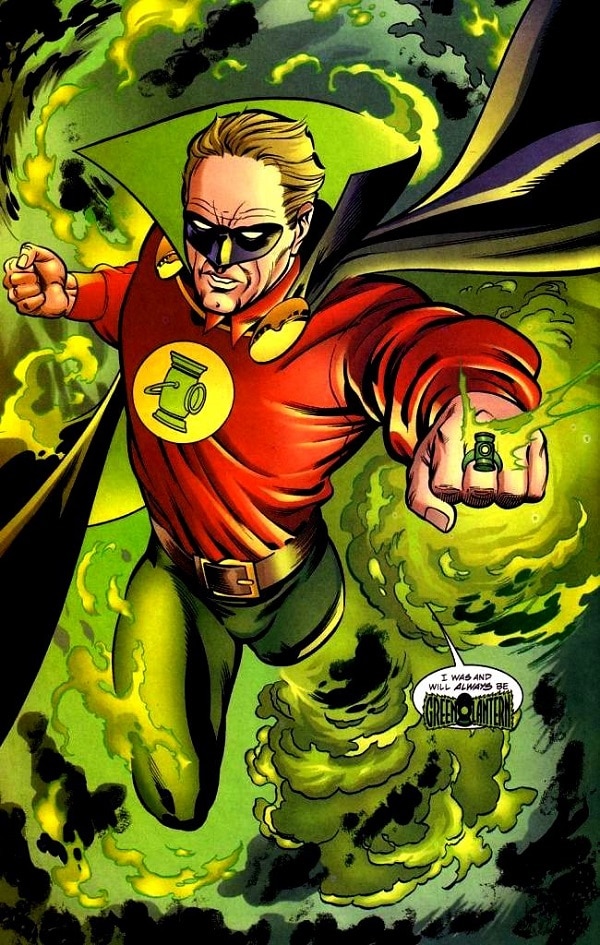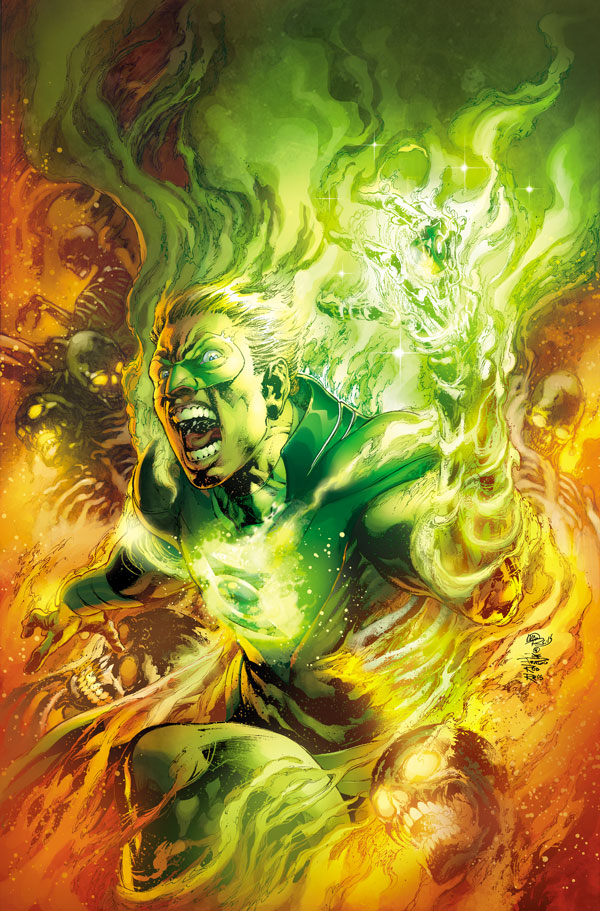DC Comics’ beloved oath-saying hero is turning 75 this year, and with a monthly series of comics still on the shelves and a new movie arriving in time for his 80th, it’s clear that the character is still running strong. However, it’s not hard to forget that much of what we associate with Green Lantern—the oath, the Green Lantern Corps, Sinestro, the constant space-faring—didn’t arrive until much later. Heck, even the most well known Green Lantern, Hal Jordan, is but a mere 56 years old. No, when Green Lantern first debuted in the pages of ALL-AMERICAN COMICS #16 back in 1940, he wasn’t an intergalactic policeman assigned to Sector 2814. Heck, he didn’t even go to outer space at all. He was a railroad engineer known as Alan Scott.

A More Grounded Shade of Green
Of all of the human Green Lanterns, Alan Scott has always been unique. Unlike later, better known Lanterns such as Hal Jordan and John Stewart, he wasn’t chosen by a Power Ring. Not exactly. Scott became Green Lantern when the Starheart—a mystical, sentient entity composed of highly concentrated magic—fell to Earth and saved him from a train wreck. Hidden within a strange green flame, the Starheart had been placed within a railroad lantern and it instructed Scott to carve a ring from its metal, promising him great powers if he did so. The Starheart (which later was revealed to be not entirely benevolent) proved true to its word, and with his self-made ring, Alan Scott became the original Green Lantern.
Wearing a costume of red, yellow and green, to say nothing of his purple cape and mask, the blond-haired Scott looked very different from all Green Lanterns since. His powers weren’t exactly what you’d expect either. While eventually Scott was able to use his ring to form the sort of energy constructs that form the core of current Green Lanterns’ abilities, at first he mainly used it to do things that were likely convenient to the writers at the time. It had the ability to fire green blasts, change the size of objects, hypnotize people, allow Scott to fly and pass through walls, and much more. In fact, just about the only thing that it couldn’t do was protect Scott against one of the most abundant substances on Earth.
Yes, Alan Scott’s power ring also has a pretty powerful weakness (one that’s not shared by any other Lantern). It’s completely powerless against wood. If Scott found himself squaring off against a villain wielding a baseball bat, using the ring’s energy to shield himself would do him no good at all.
This may seem like a strange weakness now, but it’s less odd when placed in context. Again, unlike those who followed, Scott wasn’t a science fiction hero. He was more of a street level crimefighter, who often relied on his fists to settle his problems. Most of his villains were human, used human weapons and were fought in everyday surroundings. Scott’s power ring would give him a pretty considerable advantage over them, which made putting him in anything resembling peril pretty difficult. But if in the middle of a shootout he’s unable to levitate a nearby table to use as a shield—then the stakes are a little higher.
Eventually it was made clear that the weakness wasn’t just against wood, but plants or anything made from plants. Which is more problematic than it may sound when you consider one of his biggest adversaries…

Green vs. Grundy
While most of Alan Scott’s villains were human, one of his most enduring was anything but. Solomon Grundy was first introduced in ALL-AMERICAN COMICS #61 and proved to be such a great villain for the Golden Age Green Lantern that he became a pretty regular opponent. Along with being immortal and undead, Grundy’s body is composed partially of wood and swamp matter, meaning that Scott’s ring couldn’t really hurt him or offer Scott much protection against Grundy.
While this rivalry still continues to this day, Grundy isn’t really seen as a “Green Lantern villain” anymore, having mixed things up with Superman, Batman and just about all of the Justice League.

A Long-Time Member of the JSA
Speaking of the Justice League, it’s also worth mentioning that Alan Scott is a founding member of its earlier iteration, the Justice Society of America. In fact, it’s largely through the JSA that Scott has remained an active part of the DC Universe. In the late 1940s, the popularity of super hero comics waned and Green Lantern was cancelled in 1949. Ten years later in 1959, as a part of the Silver Age, Green Lantern was rebooted and reimagined with Hal Jordan in the lead role. Alan Scott never again anchored the title.
However, that doesn’t mean he was gone forever. Eventually, interest in Golden Age heroes such as Scott was reignited and the character made his return to comics. Revealed to be living on Earth-Two, a parallel universe where the Golden Age version of heroes such as the Flash, the Atom and the Sandman along with the JSA were still active, Scott made regular appearances both as a solo character and as a part of the Justice Society. Like other JSA members, Scott was revealed to have absorbed energy in a battle with the magical villain Ian Karkull that kept him from aging, explaining how he could have fought in World War II and still appear young in the modern age.

Alan Scott Today
While you won’t find him in any of the Green Lantern titles, Alan Scott is still an important part of the DC Universe today, albeit as a considerably different character than he was when first introduced. A primary character of Earth 2, Earth 2: Worlds End and the currently published Earth 2: Society, The New 52 reintroduced Alan Scott as a young entrepreneur who is mourning the tragic death of his boyfriend when he is chosen to be Earth-2’s avatar of the Green—the energy that governs all plant life. His costume looks drastically different than it did prior to the relaunch (it bears more similarities to the other Green Lantern costumes now), his power ring is his engagement ring, which has been transformed, and his abilities are drawn from the planet itself. Fittingly, his first big battle after being introduced in Earth-2 is with that world’s version of Solomon Grundy.
Since his reintroduction, Scott has proven to be quite an inspiring hero in the Earth-2 line of comics, acting as a central figure in that Earth’s battle against Darkseid and in their current attempts to settle a new planet. It’s a fitting legacy for the Lantern who started it all.
It’s not always easy to go first—especially not in the world of comic books. But Alan Scott and his magical ring helped inspire an entire universe of stories that is now a touchstone of the DC Universe and that are still expanding and being celebrated today. Much like the trains he once steered, he got us there in thrilling style.




















